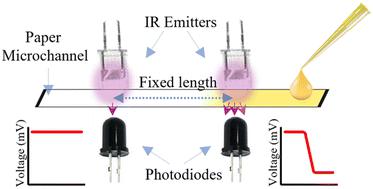Our official English website, www.x-mol.net, welcomes your feedback! (Note: you will need to create a separate account there.)
Optoelectronic microfluidic device for point-of-care blood plasma viscosity measurement
Lab on a Chip ( IF 6.1 ) Pub Date : 2024-06-13 , DOI: 10.1039/d4lc00211c Somayyeh Bakhtiaridoost 1 , Cristian Musuroi 2 , Marius Volmer 2 , Monica Florescu 1
Lab on a Chip ( IF 6.1 ) Pub Date : 2024-06-13 , DOI: 10.1039/d4lc00211c Somayyeh Bakhtiaridoost 1 , Cristian Musuroi 2 , Marius Volmer 2 , Monica Florescu 1
Affiliation

|
Physical properties of blood plasma, such as viscosity, serve as crucial indicators of disease. The inherent capillary effect of paper microchannels, coupled with minimal sample requirement, stimulated the advancement of paper-based viscometers. This study presents a precise, non-contact optoelectronic system using a microfluidic platform for the measurement of blood plasma viscosity. Microchannels were defined onto the filter paper using an available and inexpensive wax crayon, without the need for conventional wax printing equipment. The time required for the 5 μL sample to pass a specific distance was measured using two pairs of infrared sensors. Subsequently, this data was sent to the microcontroller, which automatically calculated the viscosity. Throughout the measurements, sample temperature was maintained at a constant 37 °C through an integrated heater with automated control. The microfluidic platform successfully processed real samples, yielding viscosity measurements in under three minutes. Evaluation with fetal bovine serum, spiked with varying protein concentrations in both native and denatured states, demonstrated a precision exceeding 96% compared to conventional Ostwald viscometer readings. For human subjects exhibiting pathologies affecting serum and plasma viscosity compared to physiological norms, strong correlations were observed between resultant values and clinical diagnoses. The proposed device aims to replace expensive and complex optical equipment, offering a safer alternative for measuring plasma viscosity. Unlike similar devices, it eliminates the risk of component deformation due to chemical contact or unsafe irradiation.
中文翻译:

用于现场护理血浆粘度测量的光电微流体装置
血浆的物理特性,例如粘度,是疾病的重要指标。纸微通道固有的毛细管效应,加上最少的样品需求,刺激了纸基粘度计的进步。这项研究提出了一种使用微流体平台测量血浆粘度的精确、非接触式光电系统。使用可用且廉价的蜡笔将微通道限定在滤纸上,而不需要传统的蜡印设备。使用两对红外传感器测量 5 μL 样品通过特定距离所需的时间。随后,该数据被发送到微控制器,微控制器自动计算粘度。在整个测量过程中,通过具有自动控制功能的集成加热器将样品温度保持在恒定的 37 °C。微流体平台成功处理了真实样品,在三分钟内获得了粘度测量结果。使用添加了天然和变性状态下不同蛋白质浓度的胎牛血清进行的评估表明,与传统奥斯特瓦尔德粘度计读数相比,精度超过 96%。对于与生理正常相比表现出影响血清和血浆粘度的病理的人类受试者,观察到结果值和临床诊断之间存在很强的相关性。该设备旨在取代昂贵且复杂的光学设备,为测量血浆粘度提供更安全的替代方案。与类似设备不同,它消除了因化学接触或不安全辐射而导致部件变形的风险。
更新日期:2024-06-13
中文翻译:

用于现场护理血浆粘度测量的光电微流体装置
血浆的物理特性,例如粘度,是疾病的重要指标。纸微通道固有的毛细管效应,加上最少的样品需求,刺激了纸基粘度计的进步。这项研究提出了一种使用微流体平台测量血浆粘度的精确、非接触式光电系统。使用可用且廉价的蜡笔将微通道限定在滤纸上,而不需要传统的蜡印设备。使用两对红外传感器测量 5 μL 样品通过特定距离所需的时间。随后,该数据被发送到微控制器,微控制器自动计算粘度。在整个测量过程中,通过具有自动控制功能的集成加热器将样品温度保持在恒定的 37 °C。微流体平台成功处理了真实样品,在三分钟内获得了粘度测量结果。使用添加了天然和变性状态下不同蛋白质浓度的胎牛血清进行的评估表明,与传统奥斯特瓦尔德粘度计读数相比,精度超过 96%。对于与生理正常相比表现出影响血清和血浆粘度的病理的人类受试者,观察到结果值和临床诊断之间存在很强的相关性。该设备旨在取代昂贵且复杂的光学设备,为测量血浆粘度提供更安全的替代方案。与类似设备不同,它消除了因化学接触或不安全辐射而导致部件变形的风险。












































 京公网安备 11010802027423号
京公网安备 11010802027423号